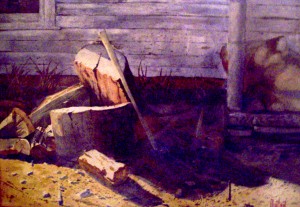
While I was painting the picture, Winter Farm, some years ago, I kept having a nagging feeling that there was a lot more than meets the eye to this old Ohio farmhouse.
There was a certain rustic presence about the place so I had approached the farmer and his wife and asked permission to be on the property to sketch and photograph it. They seemed pleased to allow me to do it, and I was pleased to be able to do it.
The tree was not in relationship to the house as I painted it. Instead, I placed it where I did to make the picture what it is. I was into the “flushing down” foreground in those days, so I felt it worked. Or, at least, it seemed to me to do so.
After the painting was finished, I began to study some of the photographs that I’d taken more in detail. Most of the photos showed a distance from the farm and barns pretty much as they are depicted in the painting. While looking over them, I began getting that same nagging feeling I had while painting the picture. Upon closer scrutiny, I realized there was something artistically picturesque near the side porch. I couldn’t quite make it out, so I took out a magnifying glass and began studying the area. Suddenly, I had one of those “Oh my gosh!” feelings.
The next day I was on my way back to the farmhouse. I timed it so I would arrive at the same time of day as before. This was critical. I had to have the bright sunlight hitting the corner of the house at an angle and contrasting with a cool shadow. What had me so excited was what I painted next.

Back at the studio, I began painting Winter Kindling with passion. After drawing my design on paper, I began covering it with my first wash. Working from bottom to top I went from warm and light to cool and dark. I left plenty of white paper in the impact areas.
I focused on the impact areas first, since it was integral to the success of the painting. I did some negative painting in a rich, dark mixture to create objects within the shadows. I used bright hues where the sunlight was falling on the chopped blocks to create a high contrast between the shadows and the objects in the foreground.
In the area between the chopping block and the foundation and wall of the house, I turned my attention to creating depth through value changes and abstract shapes. I gave the impression of clutter with chopped wood willy-nilly laying among ungroomed grass blades. I paid great detail to keep these areas remaining subtle so as not to detract from the impact area.
Ever since I painted Winter Kindling, I’ve made it a point to look within my paintings to see if they don’t hold the secrets to my next painting. It would surprise you to know how many times this has happened to me.
